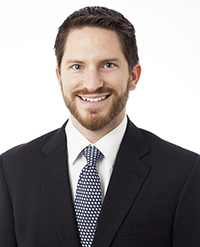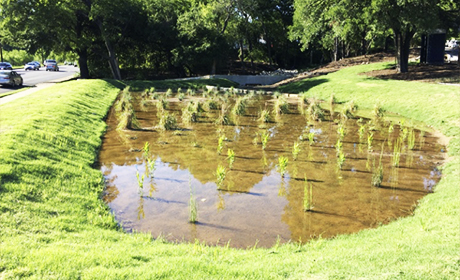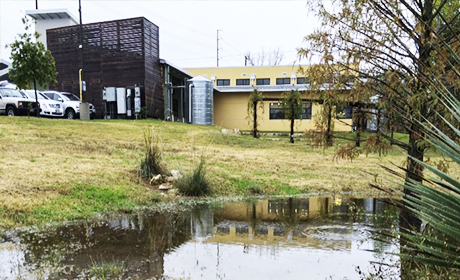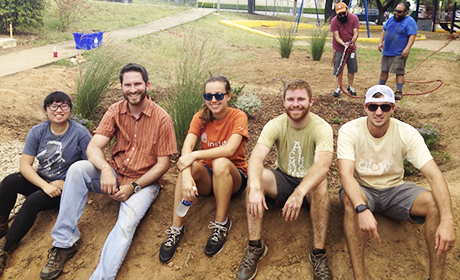News
News
News
- Details
Professor Daene McKinney was recently selected to receive the 2018 Julian Hinds Award from the Environmental & Water Resources Institute (EWRI) of the American Society of Civil Engineering (ASCE).
He is recognized for “significant and lasting contributions in groundwater systems modeling, sustainable management of water resources, and transboundary water issues; outstanding service to the profession; and exemplary application of research to national and international water resources problems.”
The award selection committee particularly noted McKinney’s leadership to the profession, especially in promoting the role of ASCE/EWRI in the World Water Council and Forum and helping to solve some of the world’s toughest water-related problems.
His research focus is sustainable management of water resources, especially in the problems of water security in high mountain glaciated basins, and the integration of engineering, economic, environmental and political considerations in transboundary basins.
McKinney will be recognized at the 2018 EWRI World Environmental and Water Resources Congress in June 2018.
- Details
The Department of Civil, Architectural and Environmental Engineering is pleased to welcome Assistant Professor Blair Johnson.
Johnson recently completed a Postdoc at Arizona State University in the Department of Mechanical Engineering. She earned a Ph.D. and M.S. in Civil and Environmental Engineering from Cornell University and a B.S. in Civil Engineering from Johns Hopkins University.
Her technical interests include environmental fluid mechanics, turbulence and mixing processes, sediment transport, and experimental methods. Johnson’s research will break down complex environmental flows into fundamental components to understand the driving fluid mechanics processes responsible for mixing and transport in the environment. This work applies to coastal erosion, volcanic eruptions, oil spills, and many other sources of air and water pollution.
Her team will study phenomena such as breaking waves, stratified flows, fluid-structure interaction, and sediment transport in a unique laboratory facility at the Center for Water and the Environment at UT Austin’s Pickle Research Center.
Johnson will begin teaching 319F Elementary Mechanics of Fluids undergraduate course during the Spring 2018 semester. She plans to create an interactive and creative classroom and lab environment that allows students to approach a multitude of challenges and successfully reach solutions.
- Details
Assistant Professor Zoltan Nagy was selected to receive the 2017 Best Paper Award from the Building and Environment journal.
His work, “Occupancy learning-based demand-driven cooling control for office spaces," has been recognized for its originality, contributions to the field, quality of presentation, and soundness of the science. It is one of three award-winning papers from over 2,000 submissions.
The research was led by Nagy and a team at ETH Zurich and was implemented in the 3for2 building in Singapore.
Building and Environment is an international journal that publishes original research papers and review articles related to building science, urban physics, and human interaction with the indoor and outdoor built environment.
- Details
Professor Emeritus James Jirsa, Janet S. Cockrell Centennial Chair Emeritus in Engineering, has been named a Distinguished Member of the American Society of Civil Engineers (ASCE).
- Details
As Tropical Storm Harvey evolved from forecast to disaster, Professor David Maidment, a National Academy of Engineering member, was on the front line, using his expertise to help protect the citizens of Texas during one of the state’s worst large-scale emergencies.
Before the Storm
For three years, Maidment and a team at the UT Austin Center for Water and Environment (CWE) helped the National Oceanic and Atmospheric Administration (NOAA) prepare to launch the National Water Model. The model, which launched in August 2016, is a real-time forecasting tool that continually simulates and forecasts how water moves throughout the nation’s rivers and streams, including 190,000 miles of rivers and streams in Texas.
Over the past year, Maidment and CWE researchers have also been working with the Texas Division of Emergency Management (TDEM) to develop a Texas Flood Response System, which will leverage the water forecasting from the National Water Model and transform it into a flood response system for the state of Texas.
His team also compiled 9.2 million Address Points from Emergency Communications Districts throughout Texas, which 911 systems use to dispatch emergency response vehicles. This Address Point map helps assess the number of people impacted when a particular community is flooded.
Hurricane Harvey: ‘We are Facing a Catastrophe’
As Category 4 Hurricane Harvey made landfall, causing major destruction along the Texas coast, meteorologists soon began to issue separate storm surge warnings of disastrous flooding. After looking at data based on the current and expected precipitation and flows across Texas, Maidment saw the writing on the wall. A historic flood was inevitable.
Recognizing that despite the state’s best efforts to assess and respond to the weather, it would overwhelm public safety agencies and first responders’ ability to protect people and their property. He told his CWE research colleagues to prepare for the worst as he realized, “We are facing a catastrophe.”
As predicted, Harvey regained strength after circling back to the Gulf, bringing a second wave of severe weather to the Houston area after it had already been pounded by heavy thunderstorms and tornadoes in some areas. Many families were already being rescued from their homes or under mandatory evacuation due to rapidly rising waters before the heaviest rainfall even began.
Houston received the brunt of Harvey’s rain, with parts of the city receiving more than 50 inches. The storm made its final landfall in East Texas and Louisiana, dropping dozens of inches of rain on Port Arthur and Beaumont for days.
Saving Lives: Data and Supercomputers Put to the Test
As flooding conditions dramatically worsened, public safety officials needed information to quickly organize large-scale disaster relief. A real-time flood inundation map of the impacted area was desperately needed to help figure out the best plan for helping people in the vast flooded zone and how to quickly and accurately get information out from emergency management channels to first response personnel.
TDEM requested the mobilization of the National Weather Center to assist with flood inundation mapping in response to Hurricane Harvey. Maidment and his team offered their technical support by engaging with the Texas Advanced Computing Center (TACC). They provided the center with terrain data and analyses, as well as computer code for the map.
In the high-performance computing environment at TACC, a map of the impacted zone, which included nearly 90 counties and 40,000 miles of flooded rivers and streams, was generated. TDEM subsequently combined that with flood mapping from other sources and swiftly delivered Governor Greg Abbott a map of Hurricane Harvey's overall impact in Texas.
State of Recovery: What's Next for Texas
Researchers made significant contributions to public safety through their technical analysis and use of advanced computing during and after the worst-recorded storm in U.S. history. The collaboration between the academic community, the National Weather Service, and local and state emergency response communities was put to the test during a time of chaos when information was needed quickly so that decisions could be made and lives saved.
As massive cleanup and recovery is underway in Southeast Texas and the Gulf Coast, Maidment is thinking about the way ahead for Texas. Continued investment in national and state water data infrastructure and learning from Harvey’s archived data are both integral. This data will help the research community and future engineers understand how such large and sustained flooding and rainfall events could have occurred and how critical infrastructures should be designed.
Maidment says, “Hurricane Harvey was the first severe flood event where flood inundation mapping was created for thousands of miles of streams and rivers in real-time. With the experience gained in this event, Texas flood responders will be able to better plan for future large-scale floods in Texas.”
- Details
Professor Ellen Rathje is the 2018 recipient of the Earthquake Engineering Research Institute (EERI) and the Seismological Society of America (SSA) William B. Joyner Lecture Award.
Rathje is recognized for her leadership across many aspects of earthquake research, as well as her impactful investigations of earthquake-induced landslides and ground failure, site response, and damage patterns for earthquakes around the world, including Haiti, New Zealand, Turkey, and the United States.
She will deliver the Joyner Lecture at the Eleventh U.S. National Conference on Earthquake Engineering, to be held 25-29 June 2018, and Seismology 2018, a joint meeting of SSA and the Latin American and Caribbean Seismological Commission to be held 23-26 April 2018.
The William B. Joyner Lecture is jointly awarded by EERI and SSA to those who have provided outstanding earth science contributions to the theory and practice of earthquake engineering or outstanding earthquake engineering contributions to the direction and focus of earth science research—together with demonstrated skills of communication at the interface of earthquake science and earthquake engineering.
The lecture honors the distinguished career of William B. Joyner at the U.S. Geological Survey and his abiding commitment to continuing communication and education at the interface between research findings of earthquake science and the practical realities of earthquake engineering.
Rathje is the Warren S. Bellows Centennial Professor in the Department of Civil, Architectural, and Environmental Engineering and also a Senior Research Scientist at the Bureau of Economic Geology at The University of Texas at Austin. Her research interests include seismic site response analysis, earthquake-induced landslides, field reconnaissance after earthquakes, and remote sensing of geotechnical phenomena.
She is a founding member of and current co-chair of the Geotechnical Extreme Event Reconnaissance Association (GEER), which coordinates National Science Foundation-sponsored geotechnical investigations around the world after major earthquakes and other natural disasters, such as floods, to advance research and improve engineering practice. Rathje is also the Principal Investigator of the DesignSafe cyberinfrastructure project, a web-based research platform for the National Hazards Engineering Research Infrastructure (NHERI) that provides computational tools to manage and analyze critical data for natural hazards research.
At the Bureau of Economic Geology at UT Austin, Rathje is a co-principal investigator for the Center for Integrated Seismicity Research and the TexNet Seismic Monitoring Program. Rathje served as a member of the EERI Board of Directors from 2010-2013 and was a member of the Scientific Earthquake Studies Advisory Committee of the U.S. Geological Survey from 2007-2013. She has published over 150 papers and has supervised the research of over 40 graduate students.
- Details
The University of Texas at Austin Bureau of Economic Geology has finished installing the state’s earthquake monitoring network, TexNet, and thanks to a new interactive website, the public can follow and sort seismic activity in Texas in real-time.
TexNet, the country's most advanced state-run seismic monitoring system, was authorized by Texas Gov. Greg Abbott and the Legislature in June 2015 with $4.47 million in state funding. Like many areas in the south-central United States, Texas has experienced an increase in the number of earthquakes during the past decade, especially in the Dallas-Fort Worth area, the Permian Basin region and south-central Texas.
The seismic monitoring system is being operated in parallel with the Center for Integrated Seismicity Research (CISR), a multidisciplinary research team led by Professor Ellen Rathje in the Cockrell School of Engineering’s Department of Civil, Environmental and Architectural Engineering and bureau research scientist Peter Hennings.
CISR is conducting fundamental research to better understand natural and induced earthquakes in Texas. TexNet and CISR include research partners from Southern Methodist University, Texas A&M University, the Southwest Research Institute and other institutions.
TexNet includes 22 permanent monitoring stations, which brings the state’s total number of permanent seismic stations to 40.
A team led by bureau research scientist Alexandros Savvaidis managed the design, installation and testing of the statewide network.
The system also includes 40 portable seismic stations that are being used to increase the density of stations in areas with increased seismicity, such as in the Dallas-Fort Worth area, South Texas, and West Texas in the Delaware Basin and Snyder area. These portable stations allow for detailed examination of the location, depth, size and frequency of earthquakes so scientists and engineers can better assess their cause.
“The earthquake data collected by the TexNet Seismic Network will help us better understand the seismic hazard and risk to the people and infrastructure of Texas,” Rathje said.
- Details
Accomplished professor and geotechnical engineer Robert Gilbert began his appointment as chair of the Department of Civil, Architectural and Environmental Engineering at The University of Texas at Austin on Sept. 1, 2017.
Gilbert joined UT Austin as a faculty member in 1993 and holds the Brunswick-Abernathy Regents Professorship in Soil Dynamics and Geotechnical Engineering. He has established himself as an expert in assessing and managing risk, consulting on a variety of high-profile projects, including flood protection in New Orleans, the Bay Bridge in San Francisco, nuclear waste disposal in Nevada and offshore oil and gas facilities around the world.
He was awarded the Outstanding Civilian Service Award from the United States Army Corps of Engineers for his service on the American Society of Civil Engineers’ External Review Panel in the forensic analysis of the levee failures in Hurricane Katrina.
“I am honored and excited to lead this department, which is consistently regarded as one of the finest in the nation,” Gilbert said. “I look forward to working with school and university leadership, as well as our outstanding and dedicated alumni, to continue to enhance our students’ experiences, strengthen our faculty community and advance our academic programs.”
In 2011, Gilbert received the Norman Medal, the highest award given by ASCE for a journal paper, and in 2016, he received the E.B. Burwell Award for his work with the National Science Foundation on the 2014 landslide in Oso, Washington. He is currently serving as a Governor for the Geo-Institute of ASCE and a member of the committee responsible for design guidelines for offshore facilities published by the American Petroleum Institute and the International Organization for Standardization.
Gilbert has also made a significant impact on teaching. In addition to teaching a variety of courses in geotechnical engineering and risk management, he has developed a senior capstone course in which students learn about the practice of engineering by applying their engineering skills to community service projects under the guidance of professional engineer mentors. A number of these projects have been implemented, including rain gardens at schools that have been constructed by volunteers from UT and the community together with K-12 students.
This year, Gilbert was inducted into UT Austin’s Academy of Distinguished Teachers. He is also a past recipient of The University of Texas System’s Regents’ Outstanding Teaching Award and the Cockrell School’s Lockheed Martin Teaching Award. Gilbert and his wife live in Austin with their four children. He lives an active lifestyle, having completed two Ironman competitions and several marathons.
Follow Bob Gilbert on Twitter @bobgilbertUT
- Details
Graduate student José Ramón Vazquez-Canteli recently received a Best Paper Award at the CISBAT 2017 International Conference for his research on reinforcement learning for buildings.
José's paper,“Balancing comfort and energy consumption of a heat pump using batch reinforcement learning with fitted Q-iteration," was one of two papers awarded at the conference.
CISBAT 2017 is an interdisciplinary biannual conference in the field of sustainability in the built environment and was organized in academic partnership with Cambridge University, MIT and the Swiss Chapter of the International Building Simulation Association IBPSA.
Since its inception in 1991, CISBAT offers a dynamic international platform for scientific exchange in fields ranging from nanostructured materials for renewable energy applications to urban energy systems.
CISBAT 2017 took place at Ecole Polytechnique Federale de Lausanne (EPFL) from Sept. 6-8 and addressed "Future Buildings and Districts - Energy Efficiency from Nano to Urban Scale."
José is a Ph.D. student and member of Assistant Professor Zoltan Nagy’s Intelligent Environments Laboratory research team.
- Details

Alumnus J. Brandon Klenzendorf (B.S. 2005, M.S. 2007, Ph.D. 2010) has been named the 2017 Outstanding Young Alumnus in the Department of Civil, Architectural and Environmental Engineering.
Established in 2003, the Outstanding Young Alumnus/Alumna Award recognizes a department graduate under 40 who has distinguished himself or herself with outstanding service and contributions to the engineering profession and community.
Brandon is a Project Engineer at Geosyntec Consultants in Austin, Texas, where he focuses on stormwater management, water resources engineering design, and regulatory compliance projects. He is also a lecturer in the Department of Civil, Architectural and Environmental Engineering and teaches a senior-level hydraulic engineering design course.
As a consultant, Brandon manages the conceptual design, planning, modeling, and quantifying the benefits of green infrastructure, particularly for retrofit situations, for various projects.

Water quality retrofit design project - Shoal Creek Restoration, Austin, TX
He also specializes in erosion and sediment control design, hydrologic and hydraulic engineering and permitting, and compliance with stormwater pollution prevention plans.

Real-time control of rainwater harvesting system for water conservation and runoff reduction - Twin Oaks Library, Austin, TX
As a lecturer at UT Austin, Brandon helps students take on real-world projects with clients and stakeholders. He organized and recruited local practicing engineers to mentor undergraduates in the CE 171P Engineering Professionalism course and eventually explanded the program by increasing the number of mentors and creating a permanent agreement with the ASCE Austin Branch to support the course. In addition, he has led the construction of several rain gardens at Austin-area public schools that are designed by students as part of this program.

Brandon has contributed for multiple years to the senior-level engineering professionalism course.
He is also actively involved in ASCE at the local and state levels, as well as the Austin Chapter of the Environmental and Water Resources Institute (EWRI). He has held multiple board and committee chair positions, served as an instructor for the local PE Exam Review course, and also mentors young engineers and inspires students to become interested in the field of engineering.
Brandon has earned recognition for his sustainable and cost-effective stormwater management approaches and contributions to technical societies and publications. His technical and civic contributions to the engineering community were recently recognized by the Texas Society of Professional Engineers when he was named the 2016 Texas Outstanding Young Engineer of the Year.







